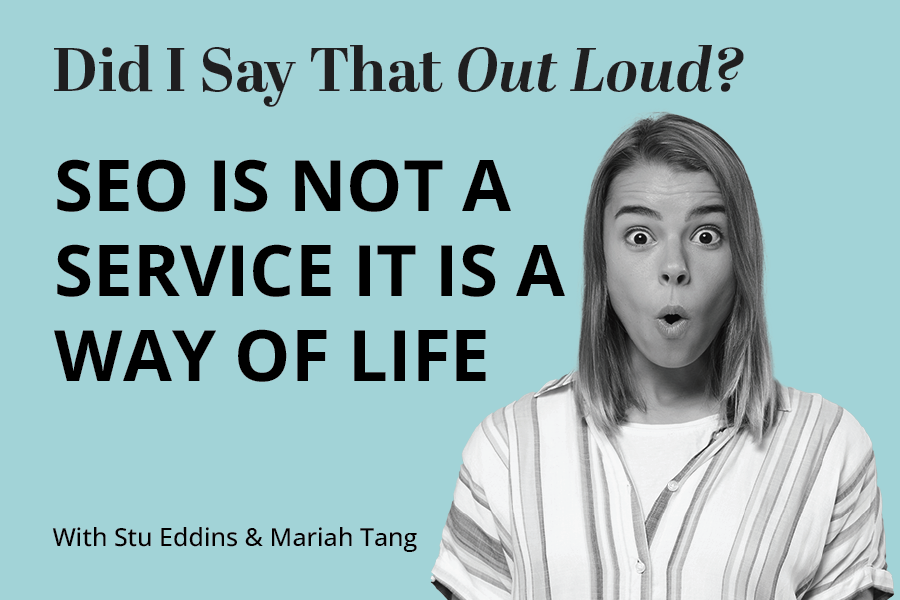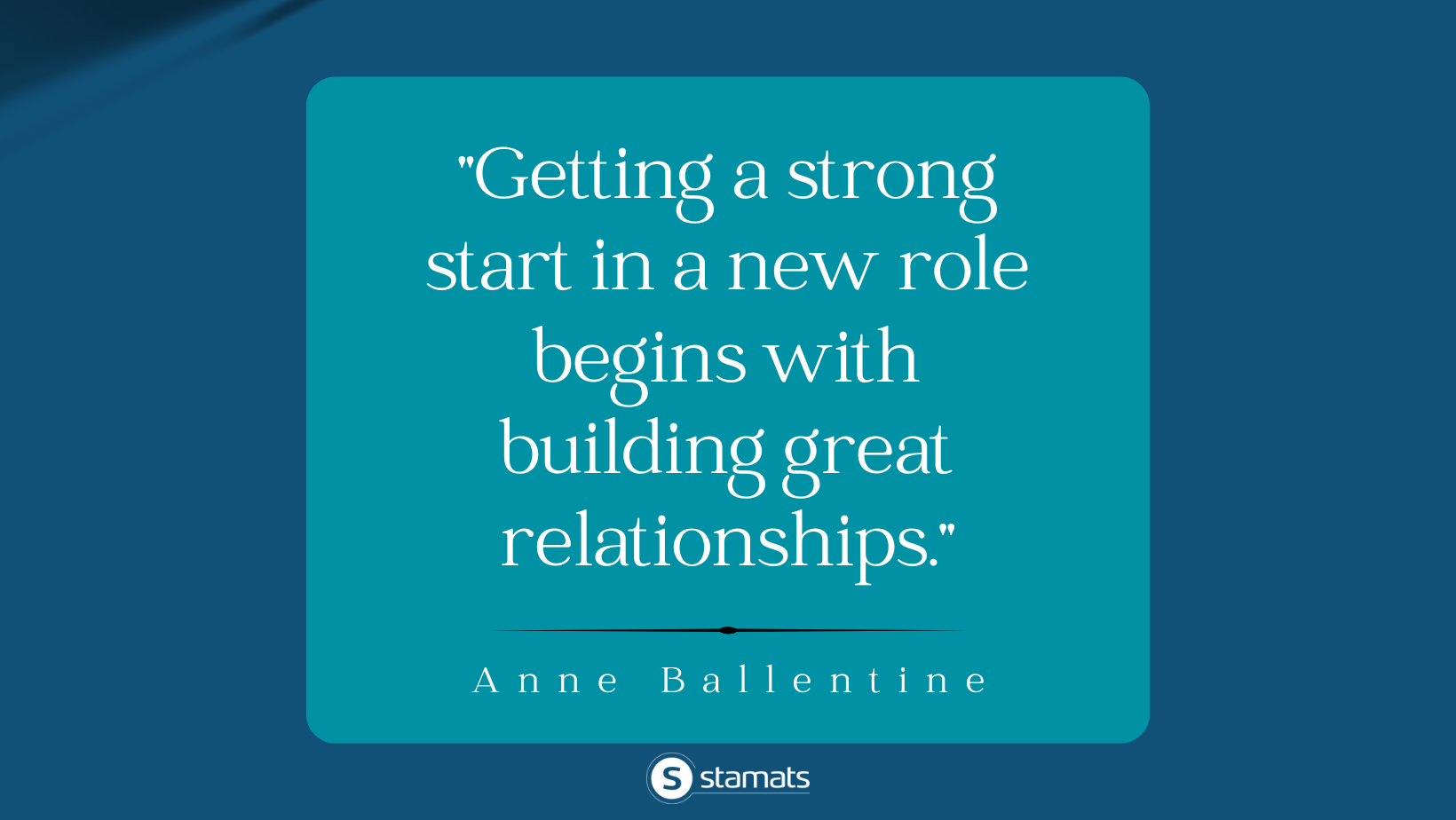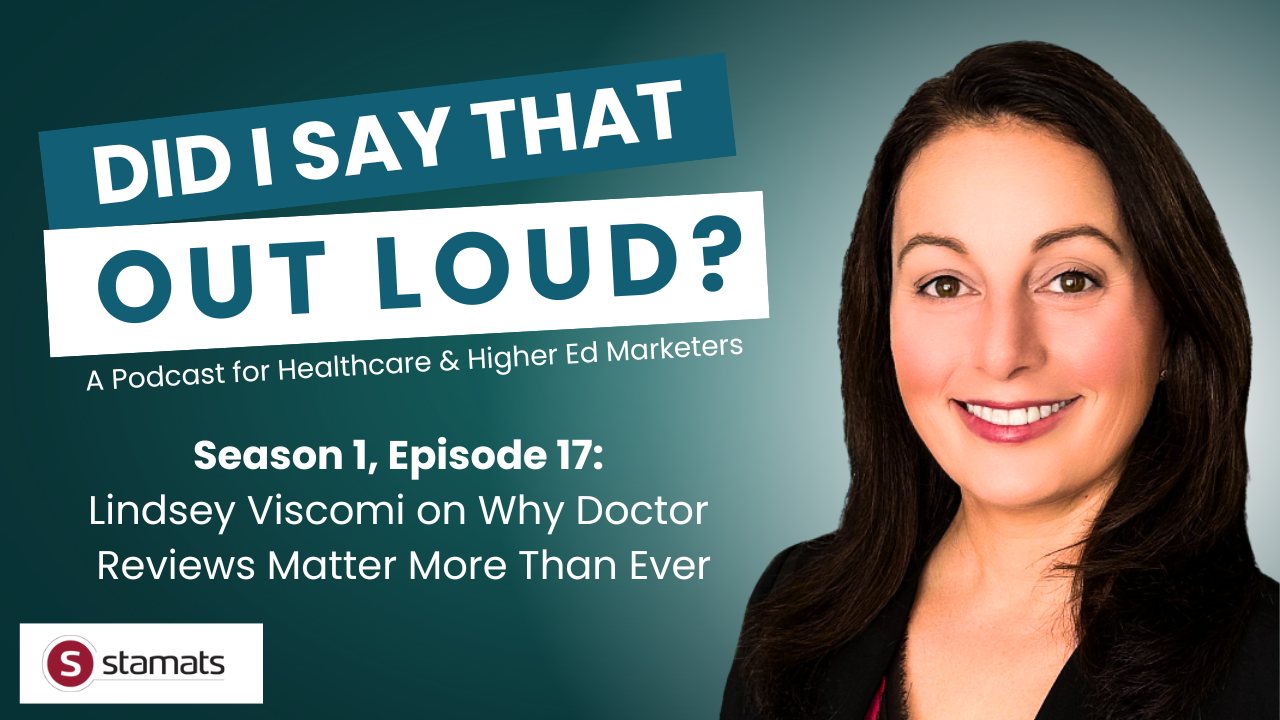Written by
on

Season 1, Episode 4
Stu and Mariah chat about what it means to “do SEO” in 2024, and how organizations can embrace the recent Google updates to truly connect with audiences.
Listen to Episode
Show Notes
Transcript
Stu Eddins: I once explained it to somebody saying take action or don’t take action, either way you’re doing SEO.
Did I say that out loud? Welcome to “Did I Say That Out Loud?”, a podcast where Stu Eddins and Mariah Tang reflect on agency life and answer questions from our higher ed and healthcare clients about the latest in digital marketing content and SEO.
Stu Eddins: Okay, hi, welcome again to the latest version of the Stamats podcast, “Did I Say That Out Loud?”
Mariah Tang: Fully caffeinated.
Stu Eddins: Yes, fully caffeinated. Yeah, it’s about 8:30 in the morning here at the world headquarters in Cedar Rapids, Iowa. Caffeine is needful. The other thing that we found is that we’re really close to some train tracks, so if you hear a pause as a train whistle sounds in the background, yeah, we’re gonna not make you listen to that and we’ll come back in afterward. Today we really wanted to talk about SEO in a in a kind of a broad sense, not how to do it, but why and what it is. “Do you do SEO?” is my favorite question to get from from clients.
Mariah Tang: Yeah, yes, we do, and so should you, and it’s a way of life.
Stu Eddins: Well, well, and there there seems to be a lot of confusion about SEO because it’s it’s both a service and an action, it seems. Doing SEO is is something like, uh, there’s this this written profile or checklist that you go down step by step. There certainly is some of that, but like you said, it’s a way of life because it also has to go back to purpose and reason for writing content. It has to be something that answers questions. We we we said this before. So really, when someone asks if we offer SEO, what are they really asking for? What do you think?
Mariah Tang: Yeah, so I want to clarify right away, we’re not talking tech SEO, we’re not talking we’re not talking backlink firming, we’re not talking schema, we’re talking about ranking well for terms, for phrases, for questions, for intent. I think when somebody asks if we if we do SEO, what they’re asking is, can you get my pages to rank higher than my competitors? Yeah, which is yes, we can, but not today, not tomorrow, probably not even next week. It’s a concentrated effort that is page by page by page. Your your site doesn’t necessarily rank for SEO, pages rank for SEO, and they all work together, and if all your pages work together, that’s how you’re going to rise in the rankings. When you say, “Do you do SEO?” yes, you have to do SEO every day cyclically because SEO changes, you know, like we talked about last time, Google changes its algorithms, people change the way that they search, people are more demanding now, they want the answer to the thing right now, and they don’t want to read your whole page, they want to be able to go right to that answer, so if you’re giving that answer, you do an SEO.
Stu Eddins: Yeah, I I once explained it to somebody saying take action or don’t take action, either way you’re doing SEO.
Mariah Tang: Yeah, yeah.
Stu Eddins: Because the the decision to not act, to not do anything is directly impacting your rankings in in search.
Mariah Tang: Or if you’re spreading the same idea across 10 or 15 pages because you can’t, right? You can’t appease your maybe your internal politically, this group wants this page and this group wants to talk about it and blah, blah, blah. That’s fine, but you need to pull them all together into one cohesive message or you’re just, it’s like diluting soup with water, you know, you’re dumping in more water thinking it’s still going to taste good and it’s not.
Stu Eddins: Right. Mulligans too. Yeah. The the, the other part about this, and you just touched on internal stakeholders and demand, all too often the requests about SEO come after a noisy stakeholder shows up at your door and says, “Why are my competitors, uh, ahead of me in search? We don’t rank for this weird obscure term.”
Mariah Tang: That’s my favorite too.
Stu Eddins: Oh, yeah, yeah, yeah. Looks, uh, I I I I can make you rank for that and all both of you that that search that way will find it. I guess the thing about SEO that that strikes me when it comes to internal conversations, just kind of going to the the management of of stakeholders, very often the stakeholders may know enough to be dangerous or what they know is from assumptions that they’ve pieced together over the years, uh, from, uh, going to conferences, from reading something, or from just being irritated because they never find them themselves in themselves in search. When we’re talking to our stakeholders about this, the one thing I would advise is it’s the the stakeholder may not be right, but it’s our job to help them be right.
Mariah Tang: Yeah, we need to help them, we need to drill down and find out what their actual concern is, what what their actual problem is and help them articulate that very, very well, or any work that we do will always miss the mark because it’s not that I’m not finding myself in search, it’s that it’s who they are finding very often.
Stu Eddins: I once helped helped a doctor and, he he came to with that same complaint, “I’m not finding myself in search.” When we drilled into this after a little discussion, a little more fact-finding, if you will, discovery, we found out that the problem was this doctor had been an instructor for years in a particular discipline, so he was at the university teaching this stuff, and his real complaint wasn’t that he wasn’t being found, is that his students were being found before him. So that actually gave us a little more focus. Now, you know, SEO is a tactic, well, maybe that’s what that’s coming down to, but that helps us help him understand the discipline of SEO and what he can expect. You said something magical, it’s not going to happen tomorrow.
Mariah Tang: Yeah.
Stu Eddins: The fact is Google will take its own dear sweet time to write, rewrite, rank things. B, Yahoo, I I’m I’m going to say Google a lot because they’re the largest player in the space. Yeah, but they they also have they also have a system that everybody else replicates. If you’re in the ad space, you’ll notice that Google does something in their Google ads and two months later Bing does it in their ad space, the exact same thing. There’s a lot of of follow the leader involved with this, so solving for Google tends to solve for everybody else. If you hate Google, sorry, but they right now are the ones who are setting the pace for most others.
Mariah Tang: Yeah, there’s one thing I want to throw at you here. Our offices are right next to each other, so Stu gets a lot of me coming in being like, “Hey, Stu, here’s the here’s the thing.” This is one thing that we talk about a lot is with with blog, which is my wheelhouse, my team’s wheelhouse, we will sometimes get a story that immediately goes to the top, it ranks for a very specific topic, whereas a web page on the same topic might take a month, two months, six months. Can we talk about that? Because I think our clients sometimes get the get the impression like, “Well, we did this story and it shot straight to the top, why doesn’t why doesn’t our page rank for this?” One reason, maybe your blog doesn’t doesn’t link to the page, but again,
Stu Eddins: Mile. Yeah, well, yeah, yeah, that that’s that’s that’s a little bit of a bunny, yeah, sure. The the the reason that can happen is because the blog tends to be fresh content, it’s something was just put out there. It may be more specific than that organic internal internal website page, is it may have a particular slant or or a particular bias toward a a search that’s happening in the moment.
Mariah Tang: Specific answer to a question.
Stu Eddins: Yeah, uh, we we had all sorts of content on a hospital website once upon a time about drug addiction, about addiction recovery, and on and on and on, but the one thing that tund it all was an article on Prince after his death. Even though every word that was in that article appeared inside, except for of course Prince’s name, inside the regular web page content, it was the article that took off.
Mariah Tang: The timely search.
Stu Eddins: Yeah, it’s the timely search. There is some degree of difference in how things rank, things that are newsworthy versus things that are are evergreen constant content. Very often we in fact use blogs for that reason, we address the thing that’s happening in the moment in the awareness of the population we’re trying to talk to, the audience we’re trying to talk to, and we do that with a blog article that that talks about those specifics, still trying to remain somewhat evergreen in the content, but we know that that’s going to percolate to the top in the results because it answers the question of the moment.
Mariah Tang: Yeah, exactly.
Stu Eddins: And and and that’s really what blog content is in my mind, and and I don’t think I’ve heard it referred to this recently, but in my mind, that’s what makes blog content variable content because you can cover the same the same topic multiple multiple times from different angles. So yeah, that’s really something that that’s important, and very often when that stakeholder comes in says, “I’m not ranking,” the first thing we’re going to do after assessing their content is consider how we can write the variable blog content that might bring this up to the top, that might, you know, that rising tide that might float all boats.
Mariah Tang: Yeah.
Stu Eddins: I think it’s changed a lot over the last as far as what what matters in SEO, like what are some of the things that you’ve seen, Stu, that that are really different now compared to, you know, 10 years ago?
Mariah Tang: Well, 10 years ago, it was keyword driven. We decided we needed to be found for XYZ and and we would use that and and how many times can we put this word?
Stu Eddins: Yeah, that’s that’s where the concept of of keyword stuffing came from, and that that concept still exists because you you don’t want to be doing that, but not for perhaps the the old-fashioned keyword stuffing reason, but because everybody would look at that as saying you’re writing for a search engine and not for a person. This is crappy content.
Mariah Tang: Yeah, yeah, yeah.
Stu Eddins: Readability, all of this stuff goes into it, and having quality content on the web now is more closely related to having quality content in Time Magazine. The the assessment of the of what’s written, how it’s written, the authoritativeness of everything from the from the author to the content itself and onward is part of it. So really, if if there’s any change, it’s that again, Google looks at context, which means all search engines do.
Mariah Tang: Yeah, to one degree or another. Yeah, user intent.
Stu Eddins: Yeah, for sure. So it and it’s the the question posed in search, it’s the answer posed on the page, and then the surrounding support of the content around the answer.
Mariah Tang: Yeah, feels SEO and Google and Bing and everybody has grown up alongside of the digital the digital search community, I guess, for lack of a better word. Like we’ve all changed how we search, we’ve changed what we expect out of the results that we get. Like you just said, if I click on something and it’s clickbait and it’s crap, people are going to say something about that, and you’re gonna see fewer followers, you’re going to see less web traffic. They’re savvy and Google sees that, they want to keep feeding the people that make the clicks that pay the bills.
Stu Eddins: Right, right. And if nothing else, Google is the world’s largest focus group, and it pays attention to how they pay attention to pages. If more people come to the page and bounce, which means less than 10 seconds, by the way, Google’s going to downrank that page. It’s not engaging, it’s doing something wrong. So, you know, there there’s a lot of assessment that goes into it, but I would really say the main difference is we have to be more on our toes now than we ever did. It isn’t simply enough to have they’re going to ask this question, they’re going to use this term, we need to have this term on our page and we need to answer it by using that term a lot. In other words, I looked up a word and the definition included that same word multiple times, which isn’t helpful.
Mariah Tang: Right, right. Tell me what to do with this information. Here’s the information, here’s what I should do with it, here’s the step you have to take to do it.
Stu Eddins: Yeah, it’s all included in that intention, right? Why are they searching it unless they want to do something with that information? Interestingly, while links have always been important, a really big deal is internal links. You’ll hear say this many times across podcasts, blogs, everywhere else, internal links help anybody, the humans, not just the search engines, understand what goes together, how does this content get supported by something else? It also is a vote internally saying, you know what, you’ve read this, you really need to go over here and read this other thing. So make the links relevant, don’t just say, “Hey, you just finished reading a a, a blog on X, we got to read really popular blog over here, you don’t care if it’s relevant or not, but you got to go over here and see it and help support it.”
Mariah Tang: Yeah, no, don’t do that. Make your links relevant to the content on the page.
Stu Eddins: Yeah.
Mariah Tang: So three, we like to end these things with three things you can do right now because we can talk aspirationally all we want, but what are we going to do with this information? So I just heard you say include appropriate calls to action and interlinking, right?
Stu Eddins: Yeah, a couple of other things. Well, the other part about it is in on the calls to action, the reason that’s important is I asked a question, you said you had an answer, now do I what do I do with the answer? The call to action may not be come have an appointment, come do this. The call to action may be learn more, do the next thing, do the next thing. Let’s lead you by the hand, let’s show you our our authoritative answers on this topic and go on. Another thing you need to do is is keep in mind that, we we we deal with a lot of clients ourselves that that have a a learning expectation that they they have a scholarly approach to things, whether it’s a doctor, a teacher, or a lawyer, they have a level of of expertise they want to convey, and for them it’s difficult to understand that they need to write at a sixth grade level.
Mariah Tang: Yeah.
Stu Eddins: Don’t talk over the head of people, understand that the people who are reading your content are more likely standing in line in Starbucks waiting for coffee than having a contemplative moment sitting at their desk at at a quiet moment in their day. It’s not happening that way. It has to be digestible, not dumbed down, but digestible. You want to hold their attention and and help them understand that you have the answer to their questions.
Mariah Tang: Yep, absolutely.
Stu Eddins: I guess the third thing is, have a purpose, have a plan. I just said repeatedly that keywords aren’t the aren’t the, be all end all and SEO. Okay, kind of, you do tend to think by grouping your your pages and your content around thoughts, we can consider those to be search terms if you will. Yeah, but you will have some target, and in that to that state, you will be thinking in terms of keywords or search terms or queries that that you need to answer. But don’t look at it as that’s the only thing to consider.
Let’s talk
You have questions, we have answers. Let’s talk about your upcoming project. Stamats addresses the challenges your team is facing. We will customize a solution that is guaranteed to impress.


